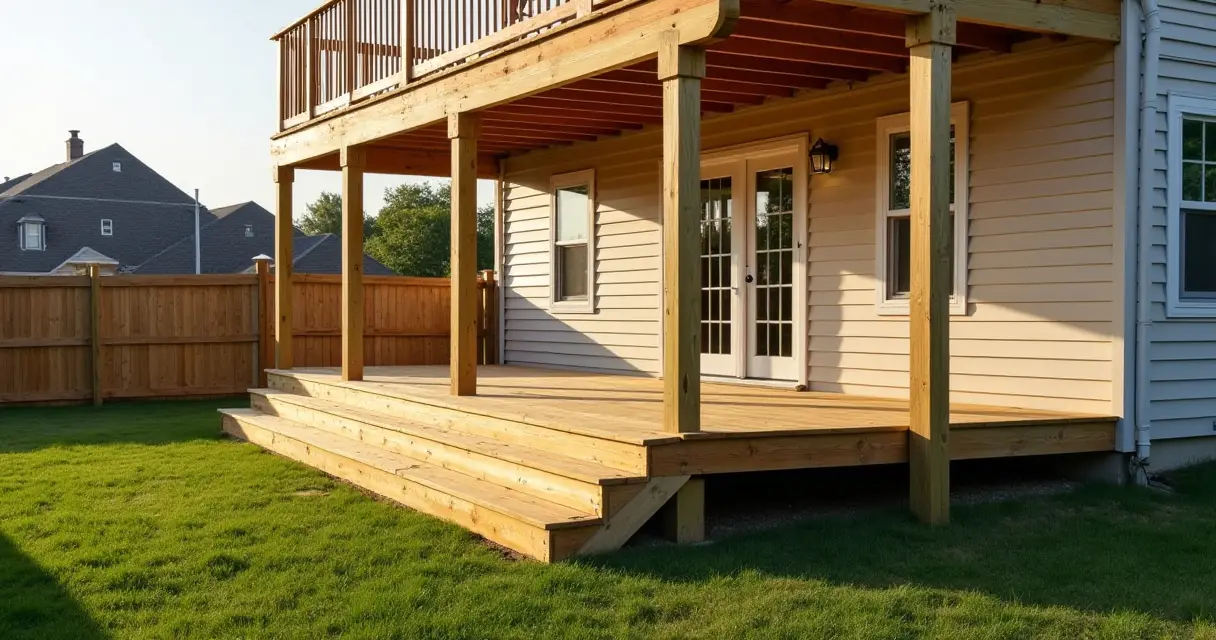You know what people always ask me about outdoor spaces? They show me a picture of a lovely porch—perfectly fluffed pillows, a charming little side table, a pot of geraniums—and they ask, “How do I get this look?” And I always tell them they’re starting in the wrong place. Anyone can buy a pillow. Creating a truly luxurious porch, one that feels like an elegant, enduring extension of your home, begins long before you even think about decor.
The truth is, a high-end porch remodel is about architecture and investment, not accessories. It’s about building a space with impeccable bones so that anything you place on it instantly looks better. Forget the fast-fashion approach to design. We’re going to talk about what actually matters—the foundational decisions that create lasting value and timeless style. I’ve seen clients waste fortunes on superficial updates only to have them fail a season later because the structure was wrong, the materials were cheap, or the planning was nonexistent. Let’s make sure that doesn’t happen to you.
Foundational Planning and Assessment for Your Porch Project (Part 1)
Before a single board is cut or a color is chosen, the real work begins. This is the unglamorous but absolutely essential phase where a successful project is made or broken. It’s about understanding what you have, defining what you need, and ensuring your vision is built on a safe, legally sound, and financially responsible foundation. Getting this right is the ultimate shortcut to a stress-free remodel.
1. Evaluate the Structural Integrity of Your Existing Porch
Let’s be brutally honest. You can have the most beautiful porch design in the world, but if the structure beneath it is failing, you’re just putting lipstick on a pig. Before you spend a dime on aesthetics, you must get a professional to assess the structural integrity. I once had a client who was ready to spend $15,000 on custom railings and a new bluestone floor, only for us to discover that the ledger board—the piece connecting the porch to the house—was almost completely rotted through. That beautiful new floor would have been in their basement within a year.
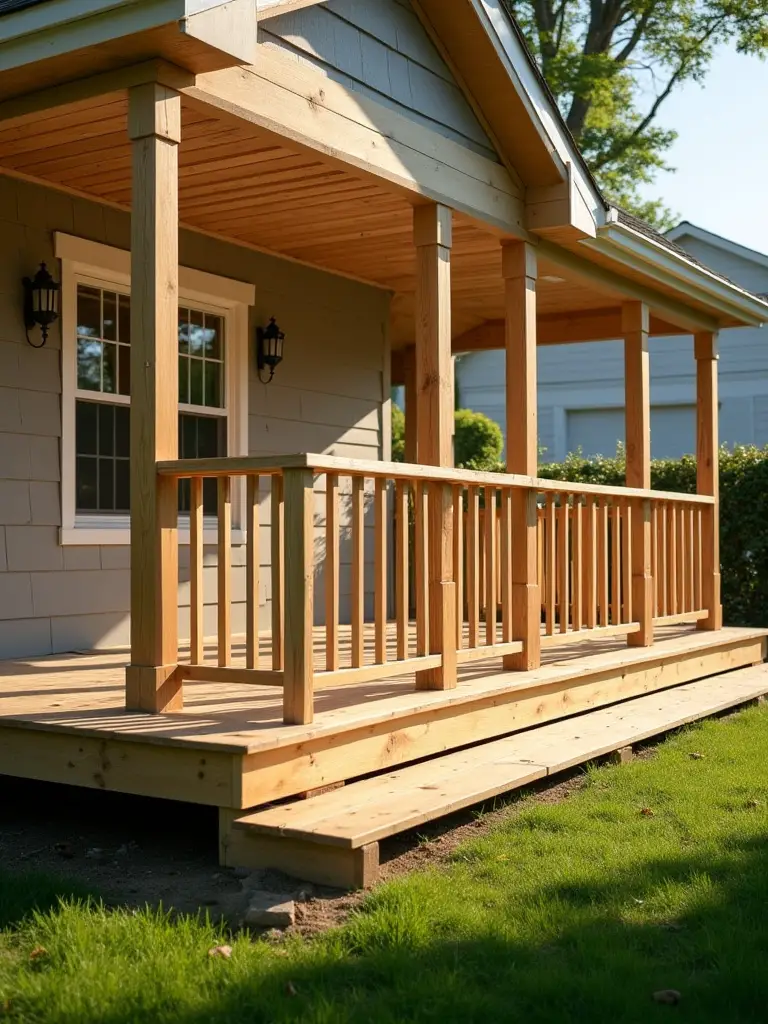
The real luxury here isn’t the fancy material; it’s peace of mind. A proper inspection of the posts, beams, joists, and foundation is non-negotiable. It prevents catastrophic failure, saves you from staggering hidden repair costs, and ensures the safety of your family. Think of it as the project’s health checkup. Skipping it is like building a priceless Art Collection in a house with a leaking roof. It’s just not a smart investment.
Now that we’ve ensured the entire structure is sound and safe, we can move on to the more creative—but equally crucial—stage of defining exactly what this space is for.
2. Clearly Define Your Porch’s Purpose and Desired Style
I always ask clients, “How do you see yourself living on this porch?” The answers are everything. Is it a quiet sanctuary for morning coffee and a book? A grand welcoming statement for guests? Or an energetic hub for cocktails and Family gatherings? A porch without a purpose is just a hallway. A porch with a defined function becomes a true outdoor room.
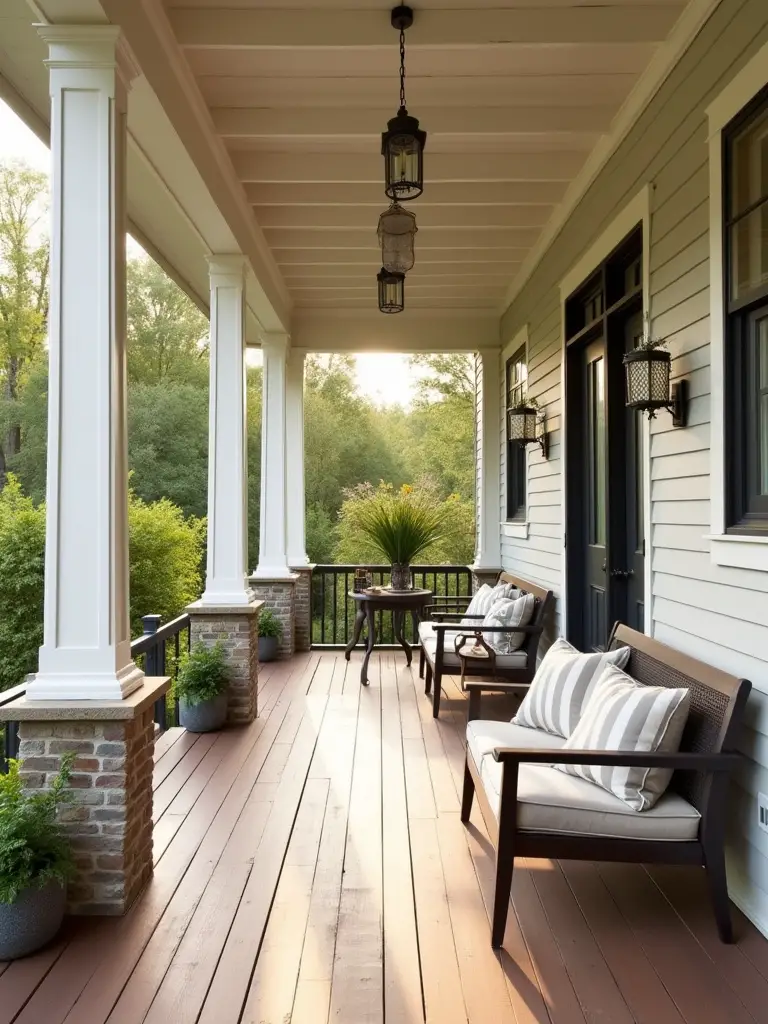
Once you know the how, you can determine the what. A dining porch needs space for a table and chairs, task lighting, and durable flooring. A relaxation porch demands deep, comfortable seating and perhaps features that enhance privacy. Your home’s architecture is your other guide. A modern farmhouse demands simple, strong lines and natural wood, while a Victorian cries out for intricate detail and traditional colors. The goal is harmony, to make the porch look like it was always meant to be there, an organic extension of the main house.
With a clear purpose in mind, the next logical step is to ground your vision in financial reality by building a practical and resilient budget.
3. Establish a Realistic Budget with a Contingency Fund for Surprises
The most elegant design can be ruined by financial stress. Can we just talk about the contingency fund? Everyone tells you to have one, but most people treat it like an optional extra. It’s not. For a remodel of an existing structure, especially an older home, a 15-20% contingency fund is the most critical line item in your budget. This isn’t your “nice-to-have” slush fund; this is your “we just found termite damage” insurance policy.
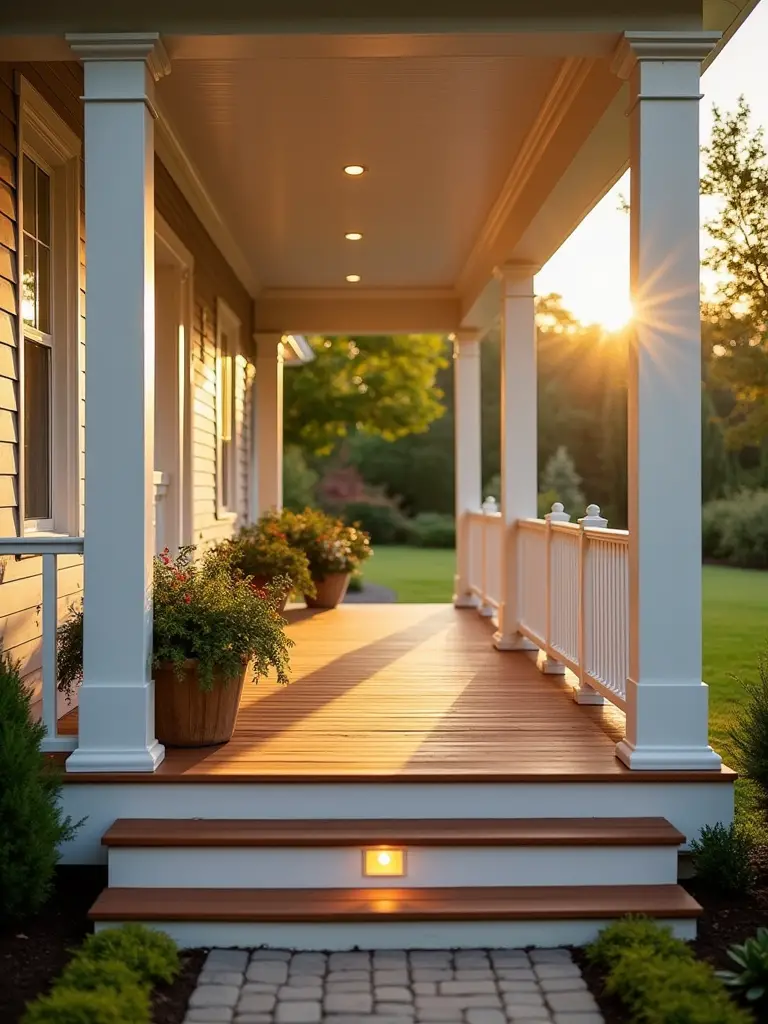
A realistic budget isn’t just a single number; it’s a detailed spreadsheet. Get multiple, itemized quotes from reputable contractors. Account for demolition, materials, labor, permits, and even debris removal. Everyone remembers the big-ticket items but forgets the “soft costs” that can add up quickly. Being disciplined here allows you to make informed decisions, prioritizing what truly matters and knowing you have a buffer for the inevitable surprise, because trust me, there’s always a surprise.
Part of that budget must also be allocated to ensuring your project is fully compliant with local regulations, a step that protects your investment from legal headaches down the road.
4. Research Local Zoning Regulations and Secure All Required Permits
Nothing stops a project dead in its tracks faster than a “stop work” order slapped on your front door. Navigating permits and zoning laws is tedious, but it is an absolute necessity. These rules aren’t there to annoy you; they exist to ensure your porch is safe, doesn’t encroach on your neighbor’s property, and is built to withstand local weather conditions. Unpermitted work is a massive liability, a red flag for future buyers, and can even invalidate your homeowner’s insurance.
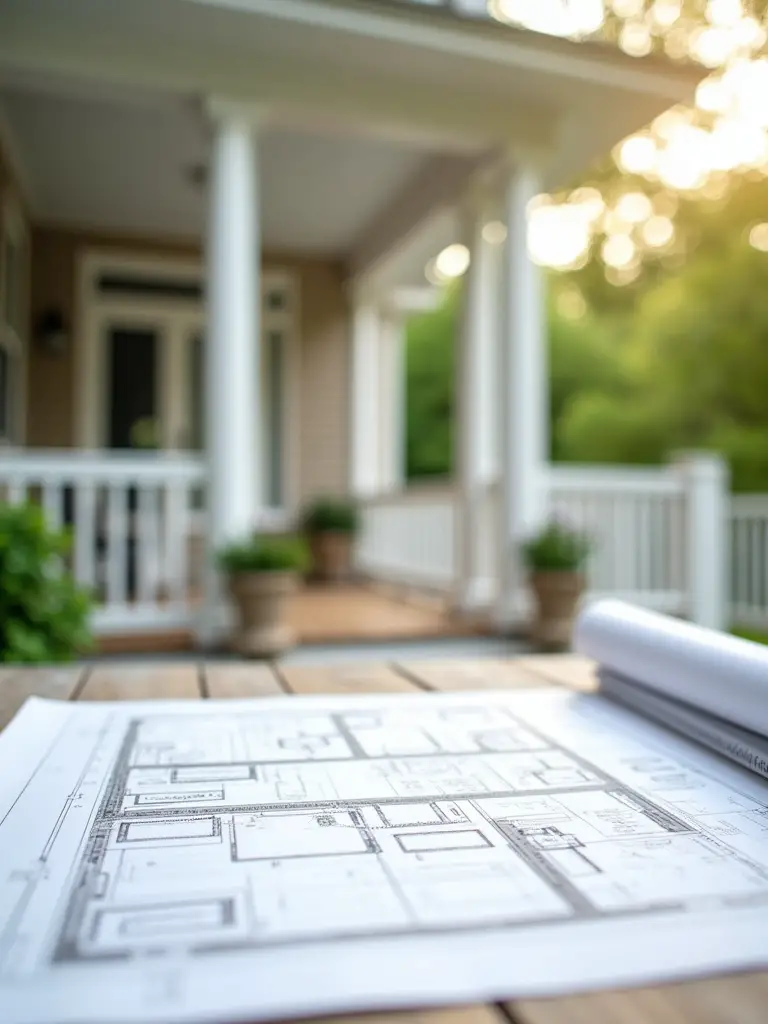
Don’t assume your contractor is handling this without seeing the approved permits yourself. Work with them or an architect to prepare the detailed drawings and plans required by your local building department. Getting everything approved before work begins is the only professional way to operate. A friend of mine once tried to enclose a porch without a permit and was later forced by the city to tear the entire thing down at his own expense. That’s a mistake you only make once.
Foundational Planning and Assessment for Your Porch Project (Part 2)
With the essential groundwork of safety, purpose, budget, and legal compliance firmly in place, it’s time to translate your vision into a concrete plan. This next phase is where ideas become instructions, ensuring that everyone from your contractor to your suppliers is working from the same playbook. A meticulously detailed plan is your best defense against miscommunication, delays, and costly on-the-fly decisions.
5. Develop a Detailed Design Plan and Curate Essential Material Lists
A vague idea is not a plan. “A modern farmhouse porch” is a starting point; a detailed architectural drawing with dimensions, material specifications, and lighting placements is a plan. This is where you finalize every single detail on paper, from the exact composite decking brand and color to the profile of the railing to the model number of the sconces. This level of detail eliminates guesswork for your build team, which in turn minimizes errors and delays.
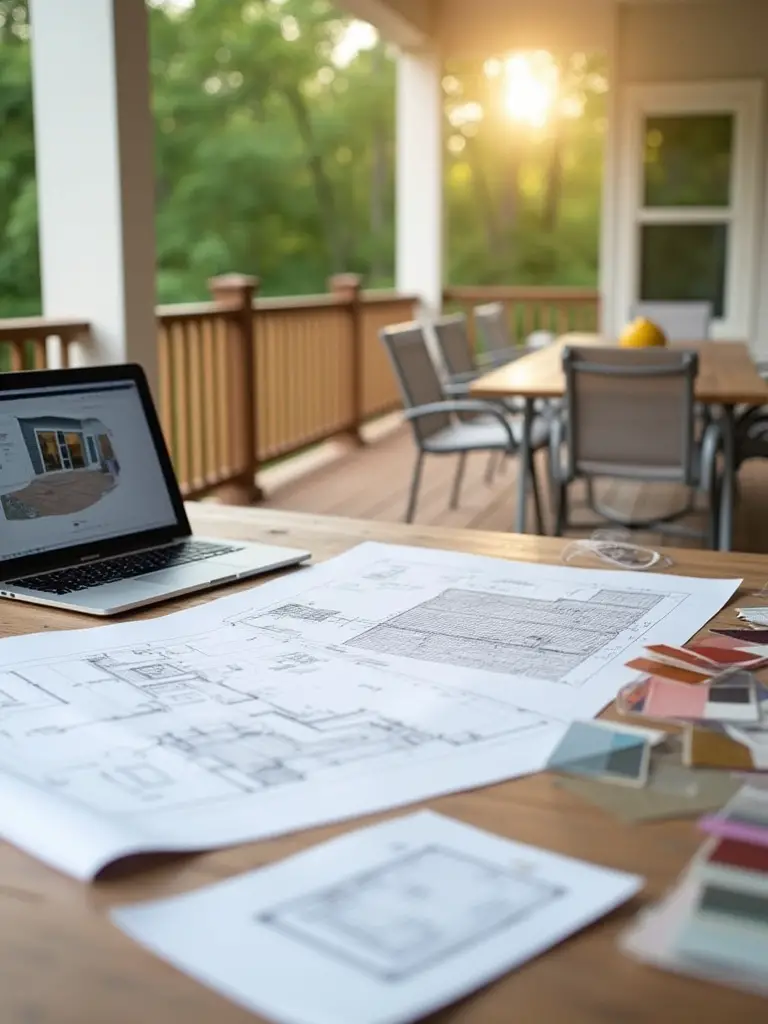
At the same time, you’ll create a Bill of Materials (BOM) that lists every single component needed for the job. This isn’t just for budgeting; it’s for logistics. You can check lead times on custom orders, verify material availability, and ensure everything arrives on site when it’s needed. I once worked on a project that was stalled for three weeks because the specific handrail brackets we needed were backordered. A proper material list curated weeks in advance would have prevented that entirely.
This detailed planning flows directly into the construction phase, where the first and most foundational choice you’ll make is the very surface you walk on.
Core Construction and Installation for Lasting Enjoyment (Part 1)
This is where your meticulous planning begins to take physical form. The focus now shifts to the core components that define the porch’s structure, longevity, and year-round usability. The choices made here are about performance and durability—selecting materials and systems designed to withstand the elements gracefully, ensuring your beautiful new space doesn’t become a maintenance nightmare in a few years.
6. Choose High-Performance, Weather-Resistant Flooring Materials
Your porch floor takes the most abuse of any element. It’s exposed to rain, snow, scorching sun, and constant foot traffic. This is not the place to cut corners. While traditional wood has its charm, modern high-performance materials like capped composite or PVC decking offer incredible longevity with minimal maintenance. They won’t rot, warp, or splinter, and they resist fading and staining far better than wood ever could.
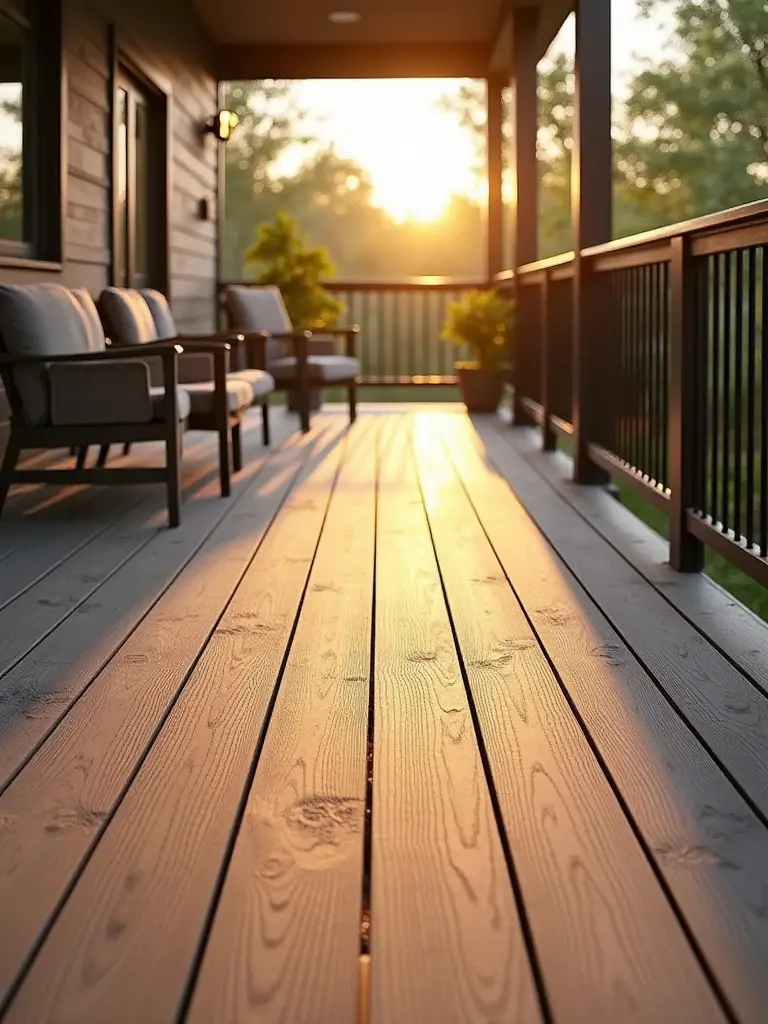
Think about the long-term investment. Yes, the upfront cost is higher. But when you factor in the cost and labor of sanding and re-staining a wood deck every couple of years, the lifetime value of a composite material becomes undeniable. It’s the difference between enjoying your porch and working on your porch. And if you love the look of wood, many high-end composites now offer stunningly realistic grain patterns and colors.
The flooring sets the stage, but it’s the columns and posts that frame the view and carry the weight of the design.
7. Select Supportive and Aesthetically Pleasing Columns or Posts
Columns and posts are the pillars of your porch’s personality. They are both a critical structural element and a primary architectural feature. Getting the scale and style right is paramount. Skinny metal posts on a grand Colonial Revival home look ridiculous; oversized, rustic timbers on a delicate bungalow are equally jarring. The columns must feel appropriate to the home’s style and proportions.
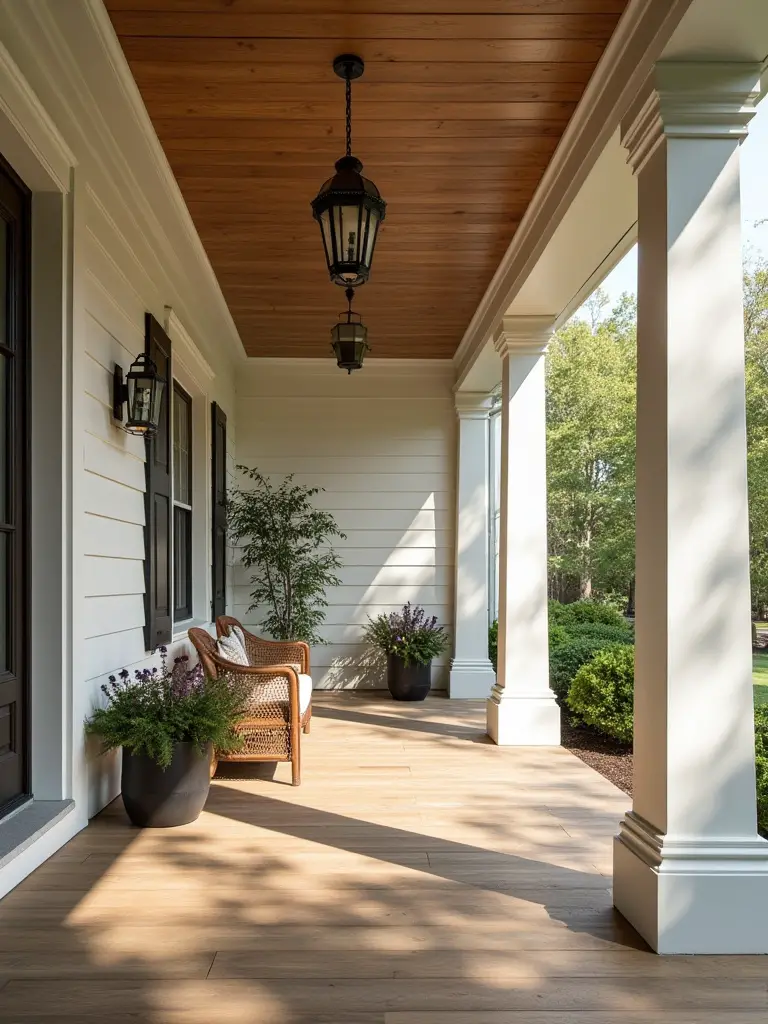
Beyond aesthetics, material choice is key. Solid wood posts require constant maintenance to prevent rot, especially at the base where they meet the floor. I often guide clients toward fiberglass or composite columns. They are load-bearing, impervious to insects and rot, and come in a vast array of styles, from simple square posts to classic fluted columns. They hold paint beautifully and provide the architectural gravitas your porch needs without the long-term upkeep.
With the vertical supports chosen, the next layer of consideration is the overhead protection that makes the space truly functional.
8. Install a Durable and Protective Roof System for Year-Round Comfort
A roof transforms a porch from a simple platform into a true outdoor room. It offers protection from the midday sun and unexpected rain, dramatically extending the hours and seasons you can enjoy the space. The roof style—be it a simple shed roof, a classic gabled roof, or a more complex hip roof—should complement the main roofline of your house for a seamless, integrated look.
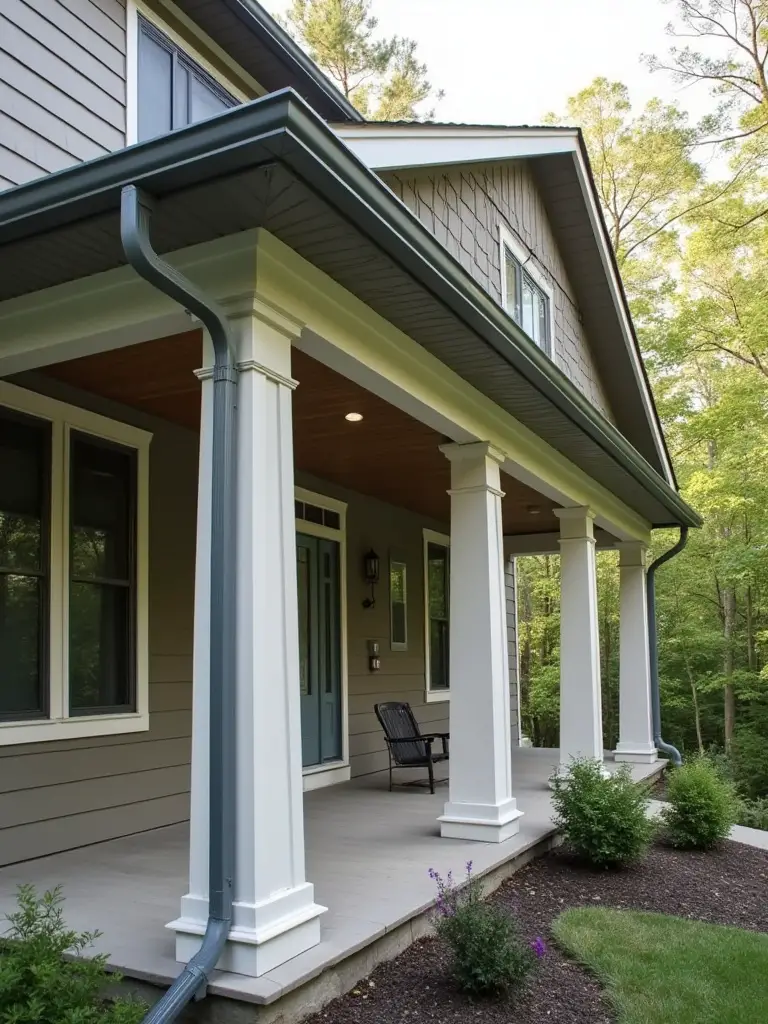
Don’t just think about the roofing material on top; consider the ceiling underneath. A beautifully finished beadboard ceiling, perhaps painted a traditional pale blue (“haint blue” in the South), adds immense character and a bespoke touch. You can also integrate elements like skylights to bring in natural light or recessed lighting and ceiling fans for comfort and ambiance. The key is to make the roof structure feel as intentional and well-finished as any room inside your home.
Properly managing the water that a roof collects is the final, crucial step in protecting the entire structure below.
9. Integrate Effective Drainage Solutions to Prevent Water Damage
Let’s talk about the least glamorous but most important part of your porch: drainage. Water is the enemy of any structure. If not managed properly, it will destroy your investment. This means more than just gutters. It starts with ensuring the porch floor has a very slight, almost imperceptible slope away from the house (about a quarter-inch per foot) so water naturally sheds off.
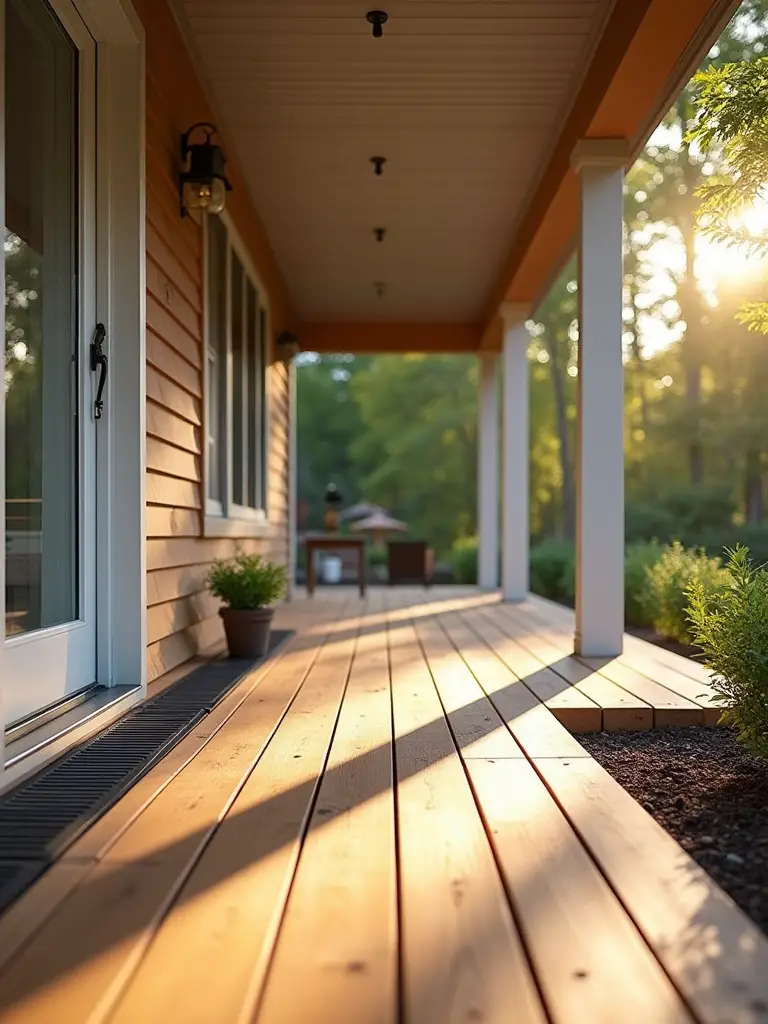
Effective gutters and downspouts are also non-negotiable. They must be sized correctly to handle runoff from the roof and direct water far away from your home’s foundation. For second-story porches, a “dry-below” drainage system can be installed between the deck joists. This captures water that drips through the floorboards and channels it away, creating a dry, usable patio space underneath. Ignoring drainage is like inviting rot and mold to set up shop.
Core Construction and Installation for Lasting Enjoyment (Part 2)
With the primary structure built and protected from the elements, we now turn to the features that elevate the porch’s functionality and safety. These are the details that ensure the space is just as enjoyable and secure after dark as it is during the day, blending robust, code-compliant features with a high-end aesthetic.
10. Optimize Overhead and Task Lighting for Ambiance and Safety
Lighting is everything. It sets the mood, ensures safety on stairs and walkways, and allows you to use your porch long after sunset. The biggest mistake people make is installing a single, glaring “bug light” by the door. A sophisticated lighting plan, just like one for an interior room, uses layers.
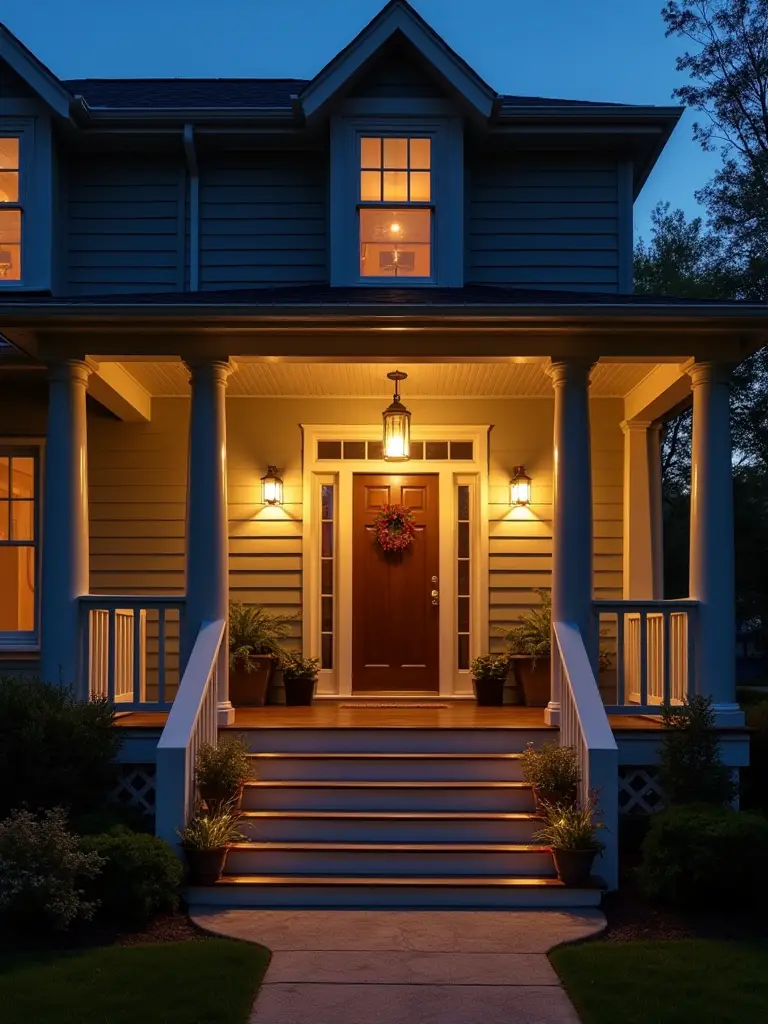
“A well-designed porch needs three layers of light: ambient for overall illumination, task for specific activities like reading or dining, and accent to highlight architectural details or beautiful plants.”
Start with ambient light from a beautiful overhead fixture or recessed cans. Add wall sconces for task lighting that also washes the walls in a warm glow. Finally, use small, discreet spotlights to graze a stone column or uplight a beautiful fern. And put everything on a dimmer. Being able to control the intensity of the light is the ultimate luxury, allowing you to go from bright and functional to soft and romantic at the touch of a button.
The final element of core construction is the railing, a feature where safety requirements and design opportunities intersect beautifully.
11. Add Sturdy Railings That Enhance Both Safety and Style
Railings are a safety requirement for any porch over a certain height (usually 30 inches), but please don’t treat them as a mere obligation. They are a defining visual element of your porch’s design. The style, material, and color of your railing can either elevate or undermine your home’s entire facade. The key is to choose a design that is both compliant with local building codes—especially regarding height and baluster spacing—and in harmony with your home’s architecture.
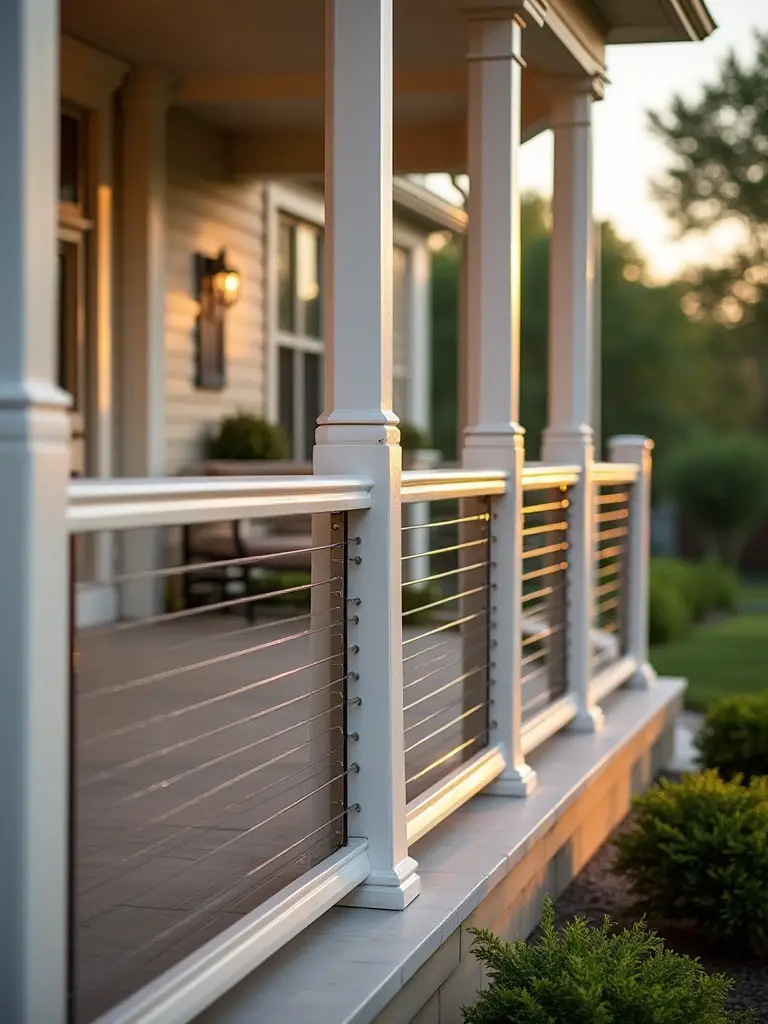
For a traditional home, a classic wood or composite railing with square or turned balusters is timeless. For a modern home, a sleeker system with horizontal cable rails or even glass panels can open up the view and create a clean, minimalist look. Whatever material you choose, ensure it is anchored securely to the porch’s framing structure, not just screwed to the surface. A wobbly railing is not only a design failure; it’s a dangerous liability.
Styling and Enhancements for Personalized Outdoor Living (Part 1)
Now that the bones of your porch are perfect—strong, safe, and beautifully designed—we can finally turn to the elements that infuse it with personality and comfort. This is where we dress the “room,” selecting furnishings and finishes that are as durable as they are elegant, creating a space that truly beckons you to come and stay a while.
12. Select Comfortable and Weather-Resistant Outdoor Furniture
The cardinal rule of outdoor furniture is this: buy the best you can afford. This is a true investment. Cheap metal sets will rust, plastic will become brittle and fade, and untreated wood will rot. Look for pieces made from powder-coated aluminum, synthetic wicker woven over an aluminum frame, or high-quality teak, which naturally resists weather. These materials are built to last for decades, not just a season or two.
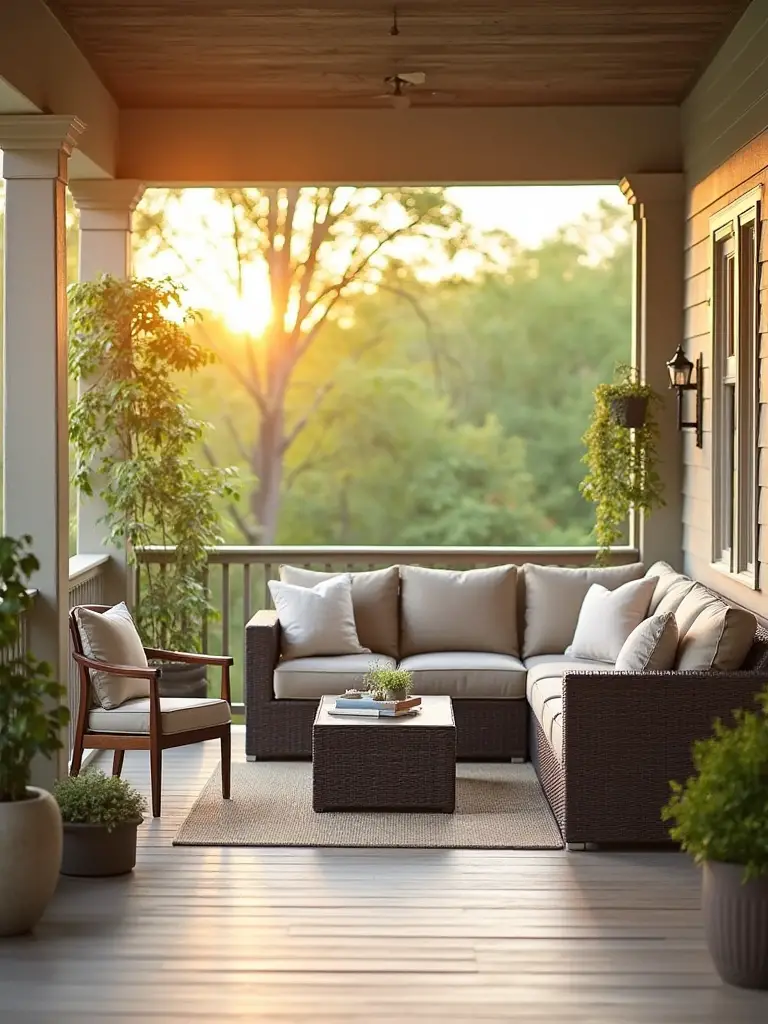
Pay just as much attention to the cushions. Insist on performance fabrics like those from Sunbrella, which are designed to resist fading, water, and mildew. The foam inside should be quick-drying to prevent it from becoming a soggy mess after a rainstorm. And remember scale: choose furniture that fits the proportions of your porch. A massive sectional will overwhelm a small space, while tiny café chairs will look lost on a grand veranda.
With your anchor furniture in place, it’s time to layer in the textures and colors that bring the space to life.
13. Incorporate Complementary Textiles and Decorative Accents
This is where you bridge the gap between your interior and exterior spaces. Bring the comfort and sophistication of your living room outdoors with high-quality, weather-resistant textiles. An outdoor rug can define a seating area and add a soft texture underfoot. Throw pillows and plush blankets in performance fabrics add pops of color and invite lounging. These elements are what make a porch feel less like a structure and more like a destination.
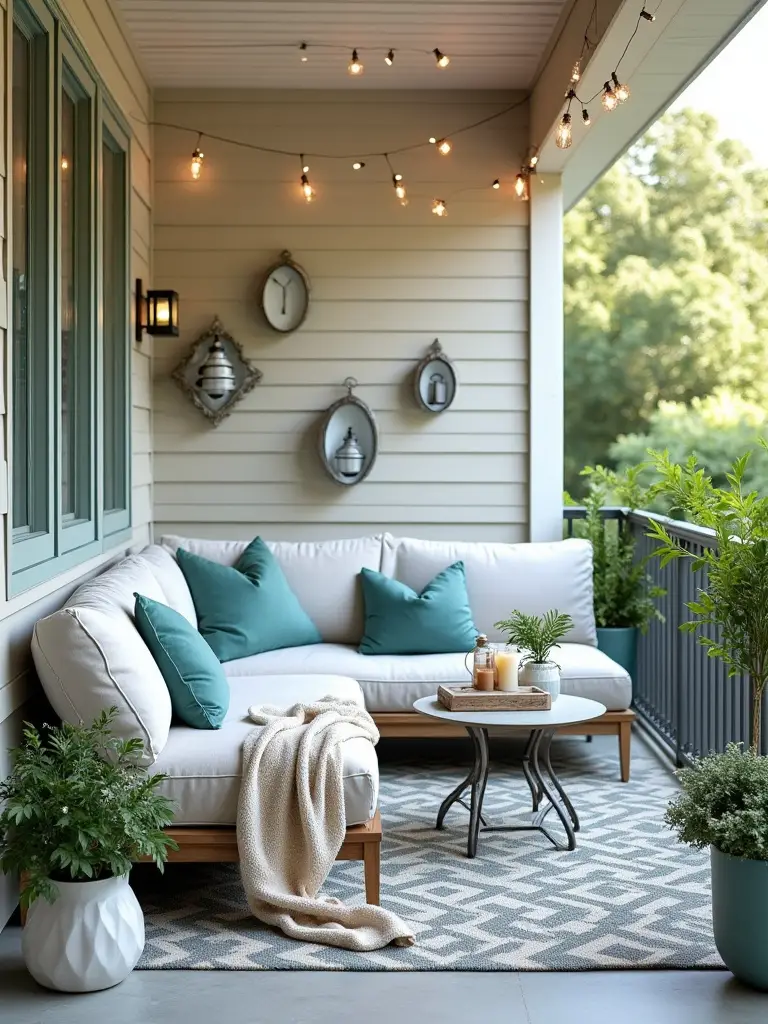
Decorative accents should be chosen with an editor’s eye. Less is often more. A few beautiful, oversized lanterns, a statement-making planter, or a piece of outdoor-safe wall art can have a much greater impact than a collection of small, disconnected trinkets. The goal is to curate a space that feels personal and polished, not cluttered.
The most vital decorative accent of all, of course, is the living, breathing element of nature itself.
14. Introduce Lush Greenery and Planters to Bring Nature Closer
Plants are the secret ingredient that brings any outdoor space to life. They soften hard architectural lines, add vibrant color and texture, and connect your home to the surrounding landscape. The key to a sophisticated look is to think in layers and vary the scale. Use a combination of large floor planters to anchor corners, hanging baskets to draw the eye upward, and smaller pots for tables and ledges.
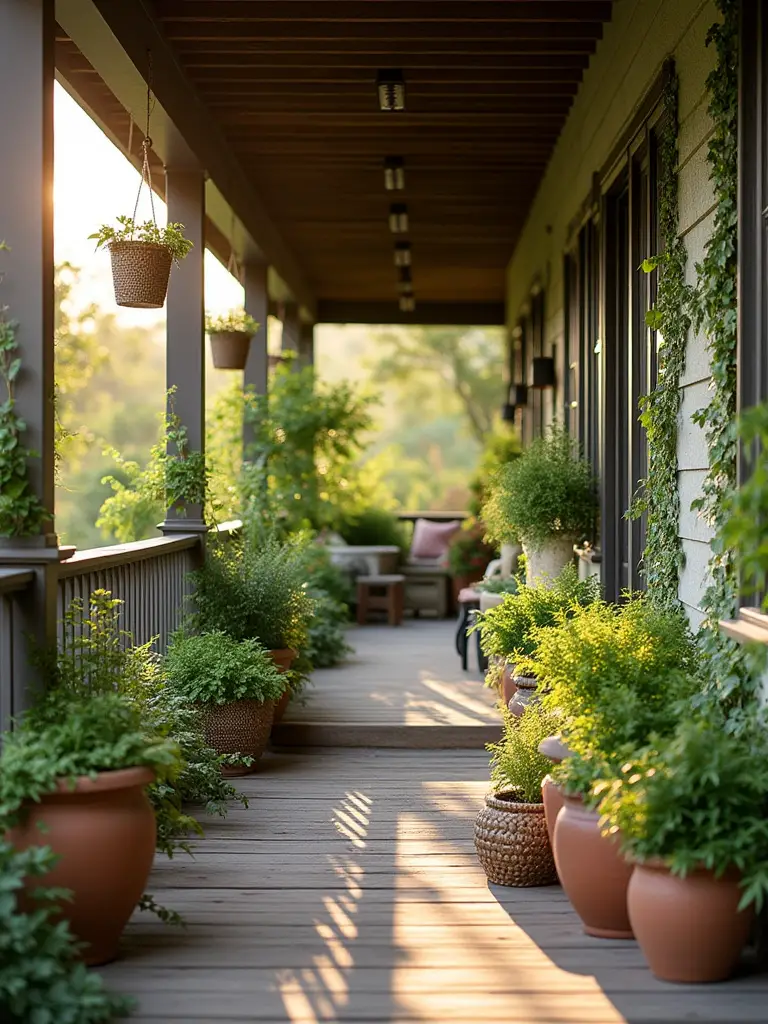
Choose planters that complement your home’s style—sleek fiberglass for a modern look, classic terracotta for a Mediterranean feel, or timeless cast iron urns for a traditional home. And be strategic with your plant choices. Consider your climate and the amount of sun your porch receives. A mix of evergreen plants for year-round structure, flowering annuals for seasonal color, and trailing plants to spill over the edges of pots creates a lush, dynamic, and professionally designed feel.
The final touch to pull the entire facade together is a fresh, cohesive color palette applied with precision.
15. Apply a Fresh Coat of Exterior Paint or Stain for Cohesive Curb Appeal
Never underestimate the transformative power of paint and stain. A fresh, well-chosen color palette can instantly unify your porch with the rest of your home, highlighting architectural details and creating a crisp, polished look. The porch ceiling, floor, railings, columns, and front door should all work together in a harmonious color story. A freshly stained wood floor provides a warm, natural base, while crisp white or deep charcoal trim can make details pop.
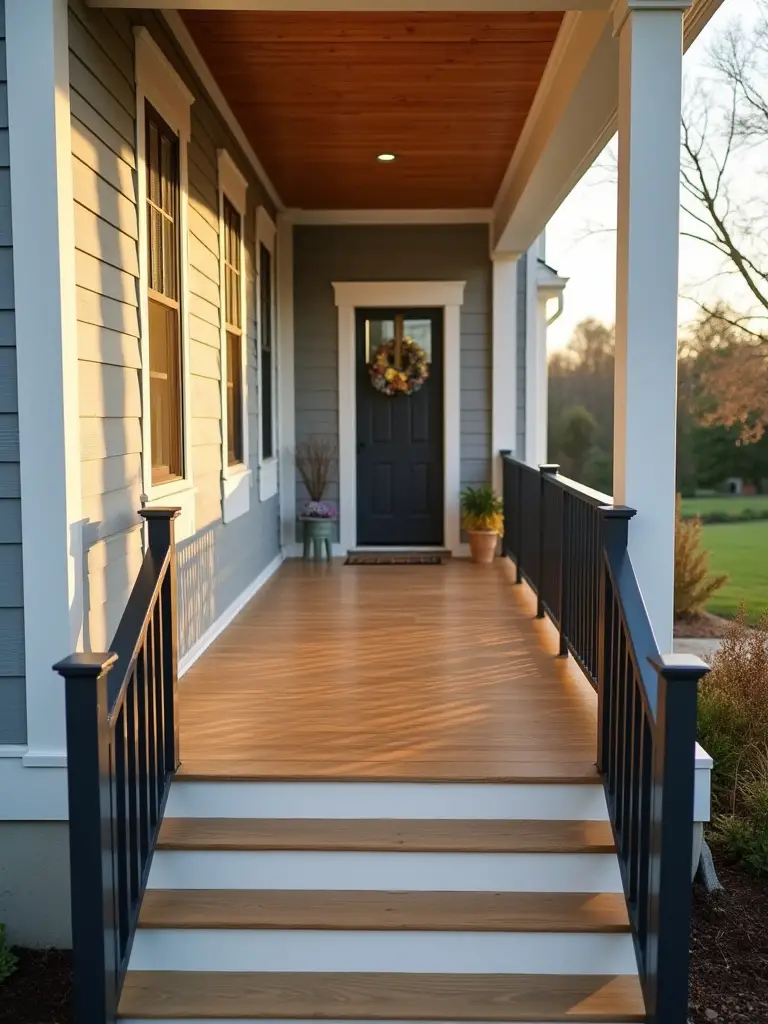
Here’s the secret nobody talks about: preparation is 90% of the job. You cannot get a lasting, beautiful finish by painting over dirty, peeling surfaces. The surfaces must be meticulously cleaned, scraped, sanded, and primed before the first drop of finish paint is applied. And please, use high-quality exterior-grade products specifically designed for their application, like a dedicated porch and floor paint that can withstand foot traffic. Doing it right means you won’t have to do it again for years.
Styling and Enhancements for Personalized Outdoor Living (Part 2)
As we refine the personality of your porch, we move beyond basic styling to more advanced enhancements that address ambiance, privacy, and modern functionality. These elements are what elevate a merely beautiful porch into a truly bespoke sanctuary—a space that caters precisely to your lifestyle needs, from intimate relaxation to sophisticated entertaining.
16. Create Privacy Solutions with Screens, Curtains, or Strategic Landscaping
A porch should feel like a secluded retreat, not a stage for the whole neighborhood. Creating a sense of privacy is essential for comfort and relaxation. This doesn’t have to mean building a giant wall. Elegant solutions can add to the aesthetic while screening views. Handsome lattice panels, modern horizontal slat screens, or trellises covered in climbing vines can create a living wall that feels lush and organic.
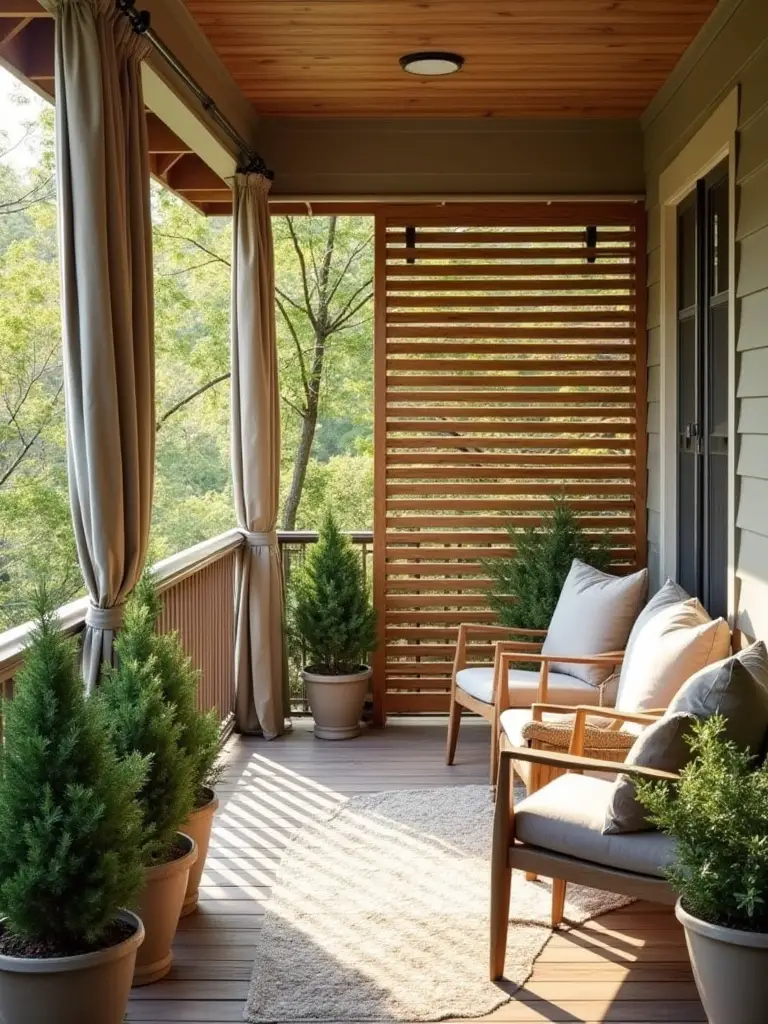
For a softer, more flexible approach, consider outdoor curtains made from weather-resistant fabric. They can be drawn for privacy or tied back to open up the space, adding a touch of resort-like luxury. Strategic landscaping is another powerful tool. A row of tall, slender evergreen shrubs like ‘Emerald Green’ Arborvitae planted near the porch can create a beautiful, year-round green screen that blocks unwanted views without feeling like a fortress.
Once your private oasis is established, you can introduce modern amenities that elevate the entire experience.
17. Install Outdoor Audio and Smart Tech for Enhanced Entertainment
True luxury is effortless. Integrating discreet, high-quality outdoor audio and smart technology transforms your porch into a seamless entertainment space. Imagine controlling the music and lighting from your phone, creating the perfect ambiance for any occasion without ever leaving your seat. Weather-resistant speakers can be hidden in ceilings, disguised as rocks in landscape beds, or mounted discreetly under the eaves.
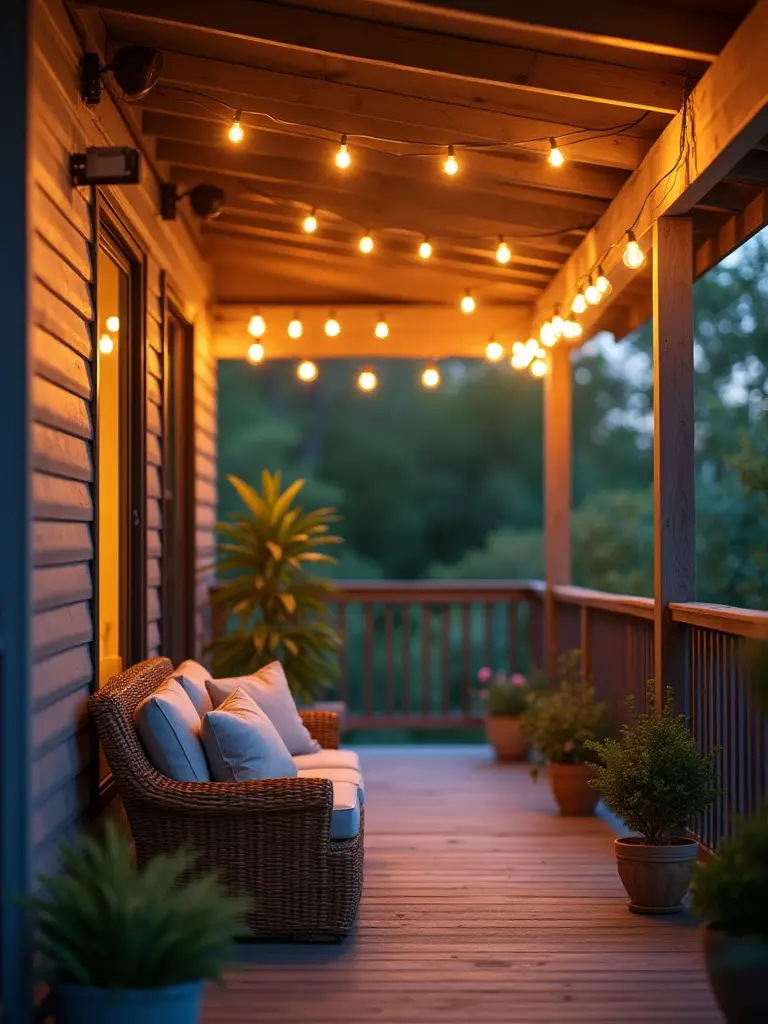
Smart technology extends beyond just music. You can integrate your lighting into a smart home system, allowing you to schedule it or adjust it with a voice command. For cooler climates, electric infrared heaters can be installed overhead, providing radiant warmth that extends the usability of your porch into the shoulder seasons. These modern conveniences are the subtle details that make a space feel truly customized and exceptionally comfortable.
With your remodel complete, the final, crucial step is to protect and maintain your beautiful investment for the long haul.
Long-Term Care and Smart Optimizations for Your Remodeled Porch (Part 1)
The work isn’t over when the contractor leaves. Your porch is a significant asset, and like any fine investment, it requires thoughtful care to maintain its beauty and structural integrity. Establishing simple, proactive routines is the key to preserving that “just finished” look and avoiding costly repairs down the line. This is about stewardship, not chores.
18. Establish a Regular Cleaning Schedule to Maintain Freshness
Dirt, pollen, and mildew don’t just look bad; they actively degrade your porch’s surfaces over time. A simple, regular cleaning schedule is your first line of defense. This means weekly sweeping to remove debris before it can stain, and a seasonal washing of all surfaces—floors, railings, and furniture—with a mild, appropriate cleaner.
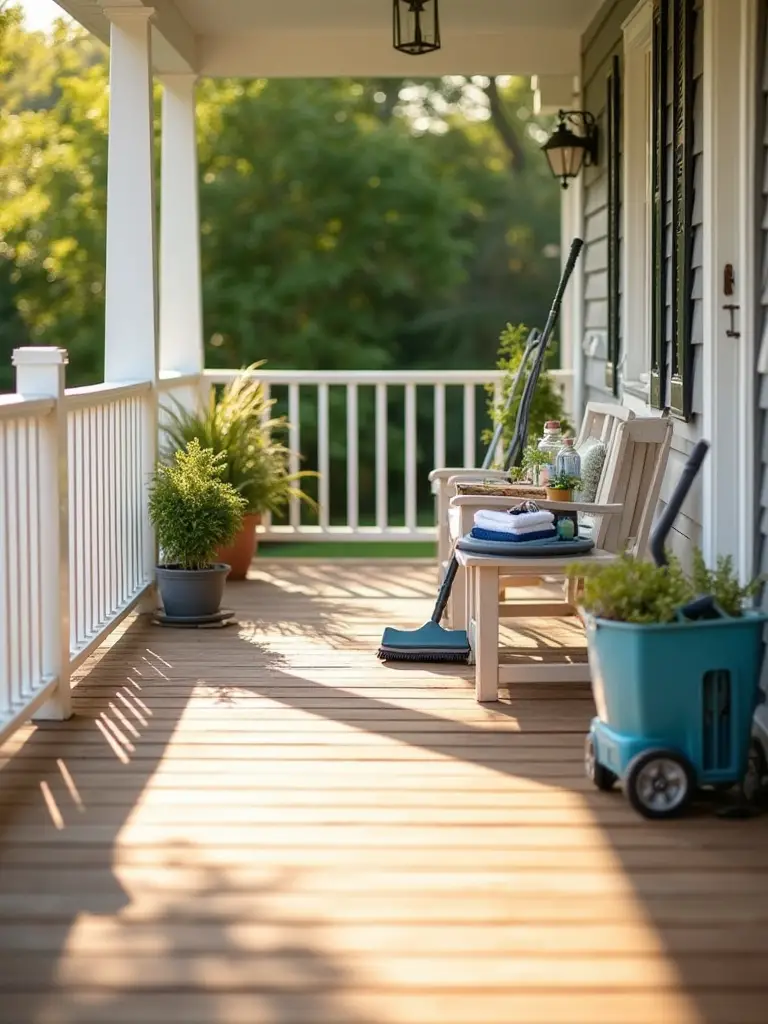
This isn’t about harsh chemicals or obsessive scrubbing. It’s about gentle, consistent maintenance that prevents grime from becoming embedded. A quick hosing down after a storm or a wipe-down of railings every few weeks makes a world of difference and dramatically reduces the need for aggressive, potentially damaging deep cleaning later on.
Part of this regular care should include a dedicated annual review to catch any potential issues before they become major problems.
19. Conduct Annual Inspections for Early Detection of Wear and Damage
At least once a year, preferably in the spring, give your porch a thorough inspection. This is your chance to be a detective. Check for any wobbly railings, loose boards, or protruding nails. Look closely at areas where wood meets concrete or where water might collect, searching for any signs of softness or rot. Examine paint or stain for any peeling, cracking, or fading.
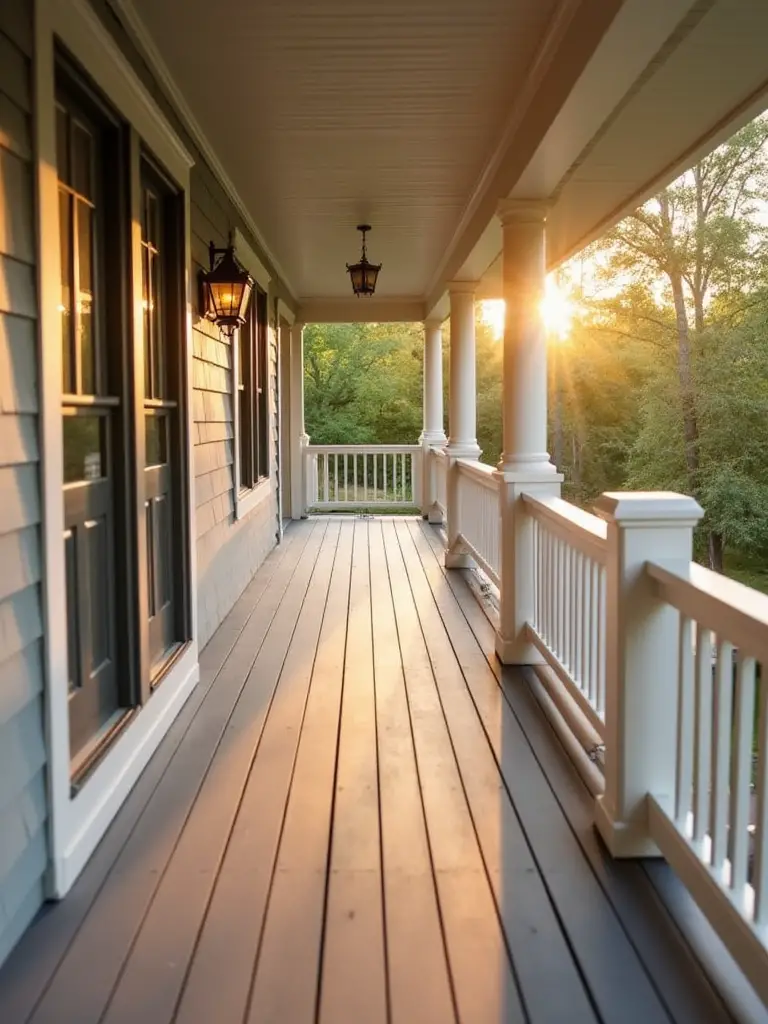
Think of this as a 30-minute annual checkup that can save you thousands. Catching a small patch of peeling paint and touching it up is simple. Ignoring it for two years until the wood beneath it starts to rot is a costly, time-consuming repair. Early detection and minor fixes are the secret to longevity.
This annual inspection will tell you precisely when it’s time to perform one of the most vital maintenance tasks: replenishing the protective coatings.
20. Reapply Sealants or Paint to Wood Surfaces for Ongoing Protection
Paint and sealant are your porch’s armor. Over time, the sun and rain break down this protective layer, leaving the wood underneath vulnerable. You must reapply these coatings periodically. The exact frequency depends on your climate and the product you’ve used, but a general rule of thumb is every 3-5 years for stain or sealant and every 5-7 years for high-quality paint.
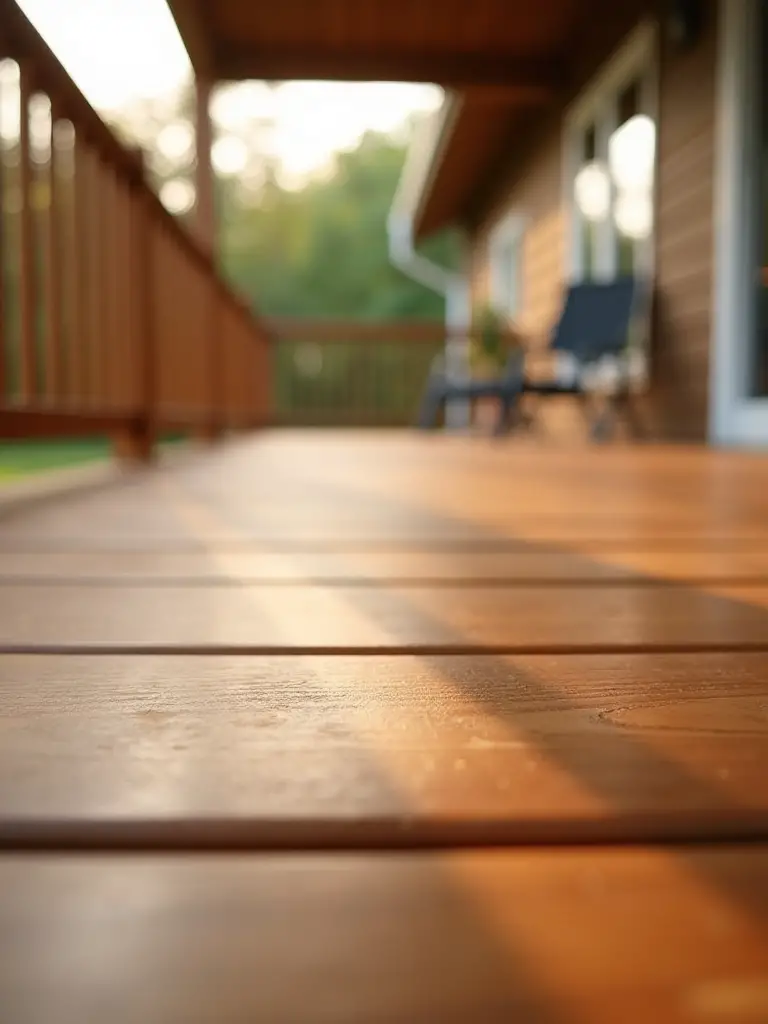
A simple way to test your wood sealant is to sprinkle some water on it. If the water beads up nicely, the sealant is still doing its job. If it soaks into the wood, it’s time to clean the surface thoroughly and reapply. Staying on top of this schedule is the single most effective thing you can do to prevent rot and extend the life of your wooden porch elements indefinitely.
Beyond general upkeep, tailoring your maintenance to the changing seasons provides an even higher level of protection.
21. Prepare Your Porch for Seasonal Changes to Extend Its Lifespan
Your porch faces different threats in different seasons. In the fall, preparing for winter is crucial. This means thoroughly cleaning away leaves and debris that can trap moisture and cause stains, storing fabric cushions and umbrellas, and ensuring gutters are clear so melting snow and ice can drain properly.
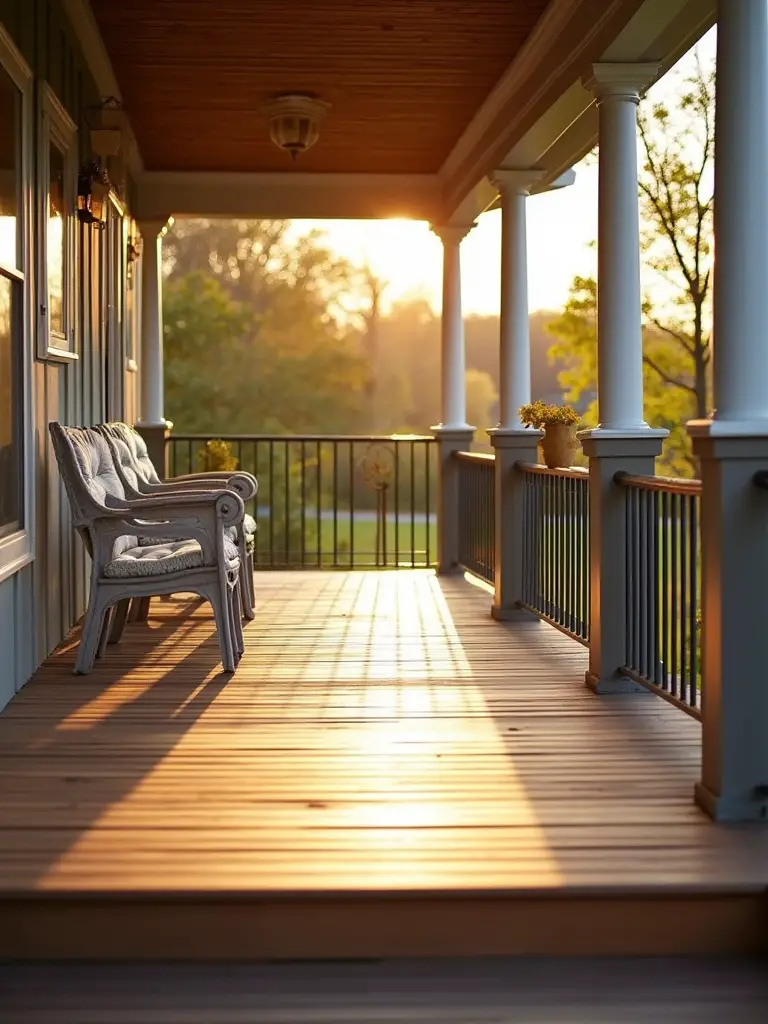
In the spring, it’s time to reverse the process. A gentle pressure wash can remove winter’s grime, and it’s the perfect time to assess any damage the cold weather may have caused. Taking these seasonal steps ensures your porch is always ready for you to enjoy and is protected from the harshest weather extremes, whether that’s heavy snow or intense summer sun.
Long-Term Care and Smart Optimizations for Your Remodeled Porch (Part 2)
Finally, let’s look beyond maintenance to optimization. A truly well-designed porch not only stands the test of time but can also contribute to your home’s overall efficiency and comfort. By incorporating smart, energy-saving features, your porch remodel becomes an investment that pays you back in more ways than one.
22. Consider Energy-Efficient Upgrades for Comfort and Cost Savings
If your porch is enclosed or partially enclosed, it can have a significant impact on your home’s energy consumption. Upgrading to energy-efficient windows and doors is a wise investment, preventing heat loss in the winter and keeping your home cooler in the summer. Proper insulation in the walls and ceiling of an enclosed porch can transform it into a true four-season room, reducing the strain on your main HVAC system.
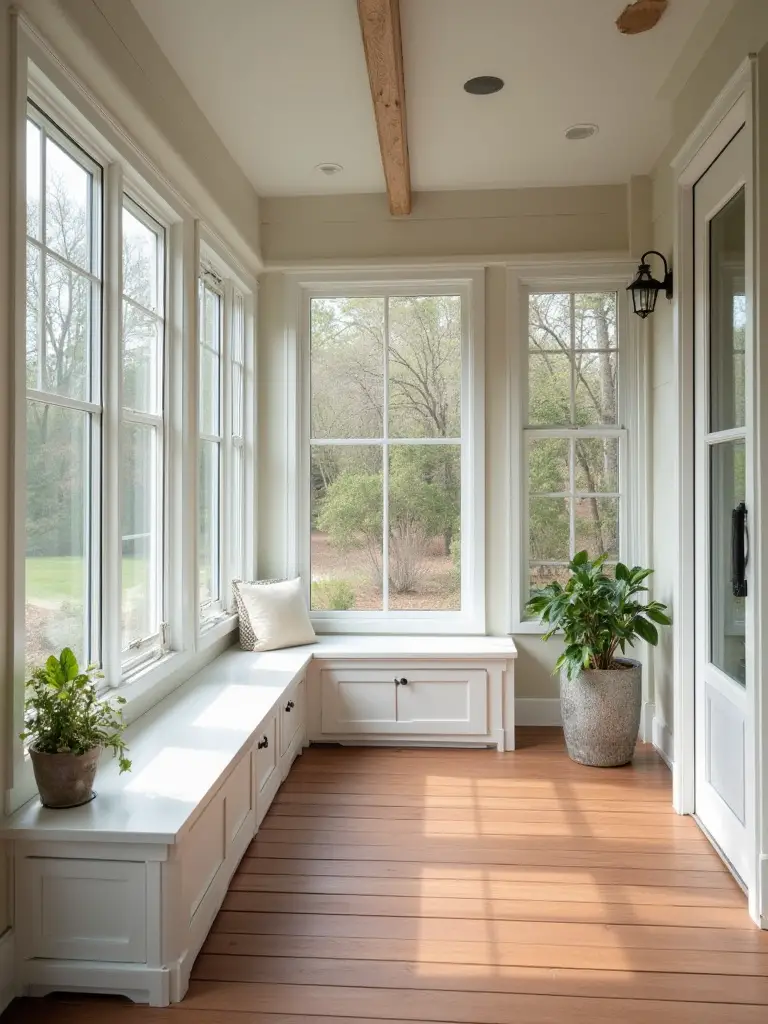
Even for an open porch, smart choices can make a difference. Installing a high-quality, energy-efficient ceiling fan can create a gentle breeze that makes the space more comfortable on hot days without a huge electrical draw. Similarly, opting for LED lighting consumes a fraction of the energy of traditional bulbs. These thoughtful upgrades add a layer of sustainable luxury, enhancing comfort while reducing long-term operating costs.
Conclusion
There you have it. A porch remodel, when approached thoughtfully, is one of the most rewarding investments you can make in your home. It’s about so much more than curb appeal; it’s about creating a destination—a space that extends your life outdoors and enhances the way you experience your home every single day. By focusing first on a solid foundation, choosing quality materials, and layering in personal, comfortable style, you create a space with timeless elegance and lasting value.
Don’t let your porch be a forgotten entryway. See it for its full potential. Whether it becomes a tranquil reading nook, a grand stage for entertaining, or simply your favorite spot for a glass of wine at sunset, a well-designed porch will give back to you for years to come. Your ideal outdoor room is waiting—go on and create it.
